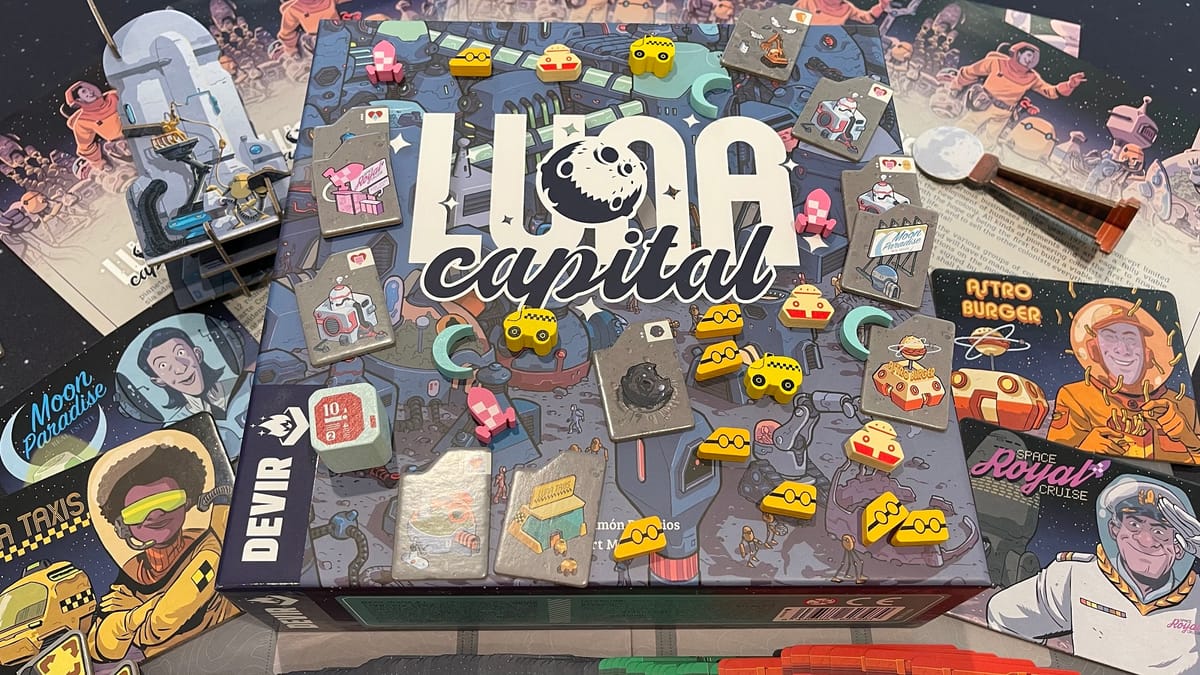
The year is 1977 and the private sector is betting on the moon as the next big market. In order for that to happen, people need to live there, so some businesses have commenced the colonization of the moon. The game is LUNA Capital, designed by Jose Ramon Palacios and published by Devir games. In LUNA Capital each player takes on the role of a group of colonists sponsored by one of four companies that are endeavoring to colonize the moon. Up to four players build out a settlement and cover it in structures with the goal of creating an efficient and attractive destination for colonists. The best colony will be declared the capital at the end of the game.
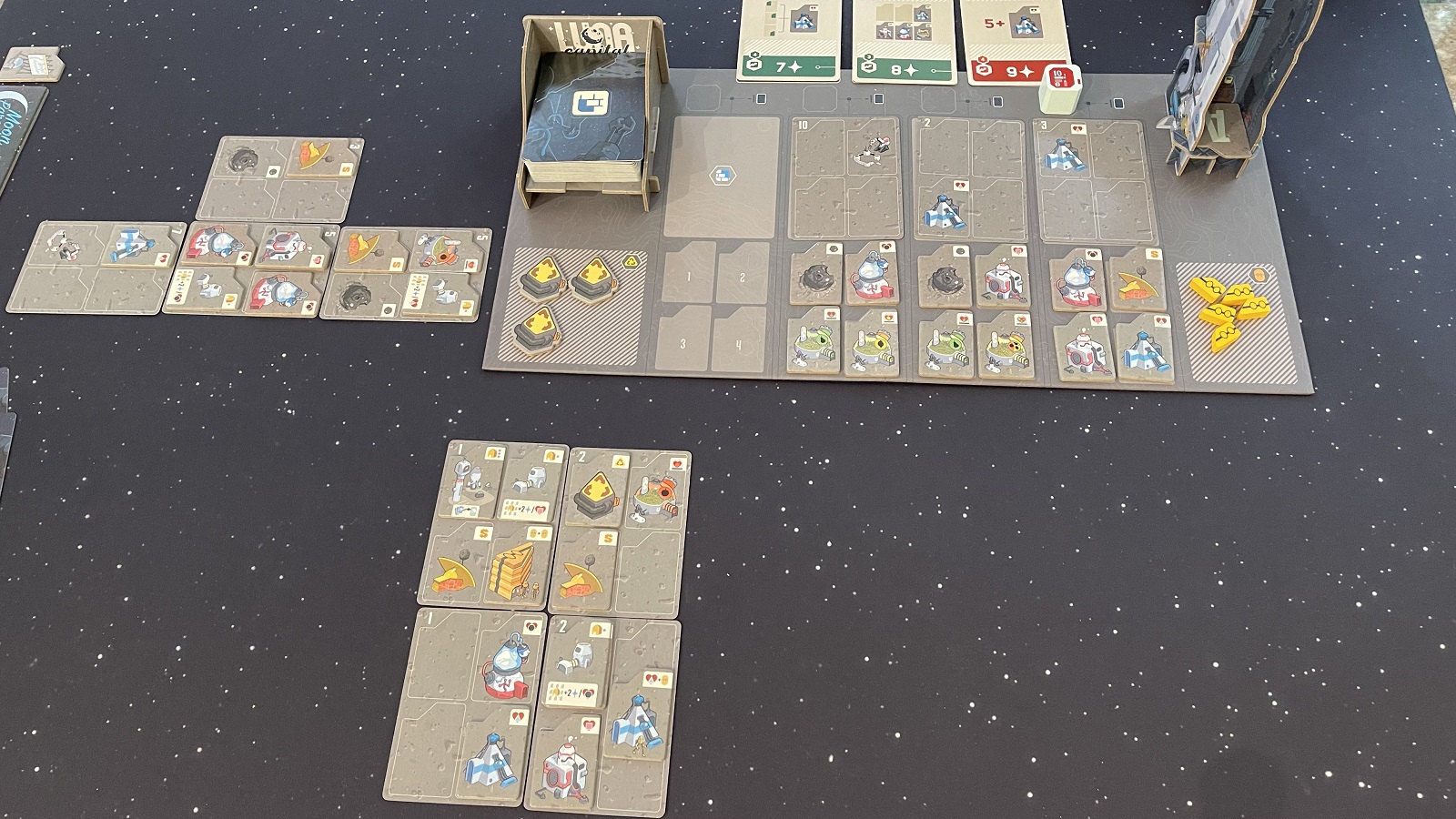
LUNA Capital two player game.
Cracking open this box is a real treat. It’s all cardboard, paper, and wood in here, with outstanding artwork and brilliant box control built in. Once you’ve punched everything out, collected all the cards and tokens into piles, and built the cardboard structures you’ll need to play and store the game, you’ll find that you have an attractive and thematic experience ahead of you. When you are ready to play, you’ll find that you have playing-card-sized Construction and Concession cards, three piles of cardboard Project tiles, wooden tokens for player identification and representing Selenite Robots, a wood Last Delivery Marker, some cardboard player identification tiles, four cardboard Logistics Redistribution tokens, a double-sided board, a score pad, and a First Player marker. You’ll also get three items that you build out of cardboard: a card dispenser, a token dispenser, and a token holder box insert.
The sixty-eight Construction cards, used to build out the area on the Moon where the players will build their colonies, are illustrated with the lunar surface on the play side with plots of land outlined for placing Project tiles. Many of the Construction cards come with one of the plots of land already occupied by a project or scaffolding. Each Construction card has a number in the upper left corner ranging from one to ten. The cards are nice quality and the graphic design is useful and clear.
The twenty-four concession cards are divided into two groups, fifteen short-term and nine long-term concessions. These cards have iconology on them to represent different combinations of projects that players can attempt to replicate in their colonies for points. The iconology on these cards can be a bit tough to follow at first. Players will likely have to reference the rulebook several times during the game to remember what the cards in any particular game mean.
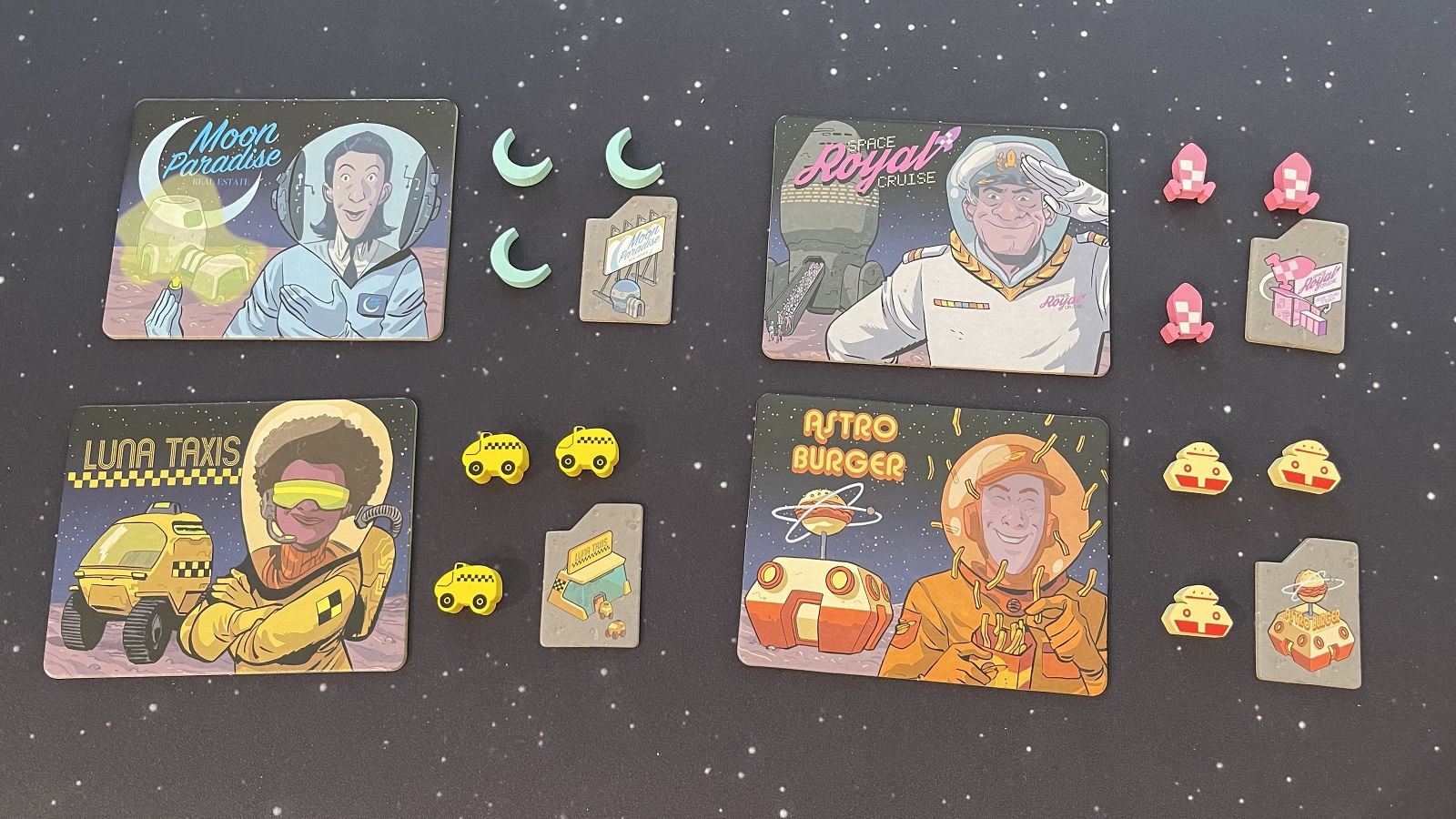
Player tokens.
Each player will have a Sponsor tile and three corresponding Identification Tokens. The Sponsor tiles show the name of the company, its color, and some thematic artwork that matches what they do: Astro Burger (a space fast food chain); Moon Paradise Real Estate (a space developer); Luna Taxis (space taxi service); and Space Royal Cruise (a space tourism concern). The Identification Tokens are correspondingly thematic: restaurants, taxis, and spaceships are obvious, then crescent moons for the real estate company. While none of the themed player components have any impact on gameplay, they do help players identify which player has scored various concessions and they also immerse the players in the lunar theme.
There are 165 Project tiles in the game, divided into three groups of 55, labeled “A”, “B”, and “C” on the back. The tiles, sized to fit four on the Construction cards, show different types of projects that players can build. The artwork and iconography help players to identify at a glance what the tiles represent. They can be green houses with different types of fruit trees, collectors of oxygen, hydrogen, or water, living modules, and other things. The three different sets are used during the three different phases of the game. You also use fewer tiles for fewer players, so some are removed from each stack before a game depending on the number of players.
The cardboard card dispenser, token dispenser, and token holder box insert are not necessary, but they are certainly useful. The spaceship-shaped token dispenser adds to the flavor of the game. All three fit into the box according to a shadow outline printed on the inside of the box that contributes to some pretty good box control. The game travels well – the cards and pieces can be kept in manageable order just with what Devir has provided you in the box.
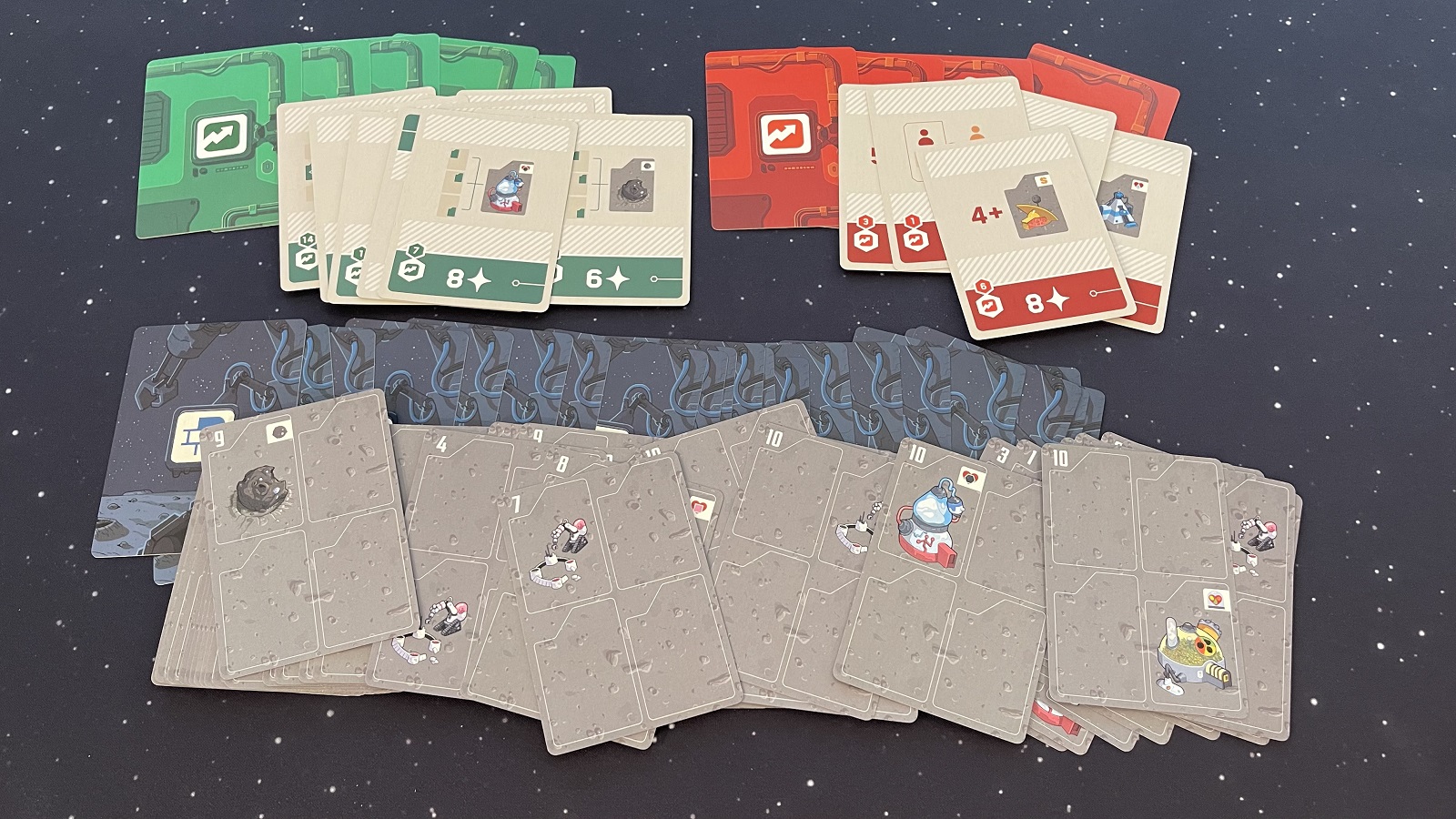
Concession and Construction cards.
Learning the game is relatively straightforward. The rulebook is clear and concise. There is a reference section for each type of Project tile, a reference chart for the Concession cards, and a section detailing scoring – which is necessary, since scoring is the most complicated part of the game. In fact, more examples on scoring wouldn’t have been a problem.
During the game, players will place up to three rows of Construction cards into a tableau in front of themselves. The cards must be placed in each row, with the lowest number on the left and highest number on the right. The amount of cards in each row is technically unlimited, but the highest numbered card is ten, so there is a sort of limit. A player can cover the number of a card with a Selenite Robot to play it in the row without regarding the numerical sequence for that card. There are twelve turns in a game, so each player is going to play twelve cards into their tableau.
Players place Project tiles on the Construction cards with an eye towards the victory point conditions for each type of project. Depending on how the specific Project tile generates points will affect how the player puts them into the available spaces on their Construction cards. For instance, fruit orchards score victory points based on the largest connected group of one type that the player has, for instance, trying to group all of the apple orchards together is the best way to score those points. Other tiles score points based on how many other tiles of the same type are on the player’s Construction cards, or various other methods. It takes a while to get a good grasp on the different ways tiles score at the end of the game, but once players have it down, they’ll be looking for ways to maximize their score and eyeing the available Construction card and Project tile combos, hoping the one they want stays in play until they can grab it.
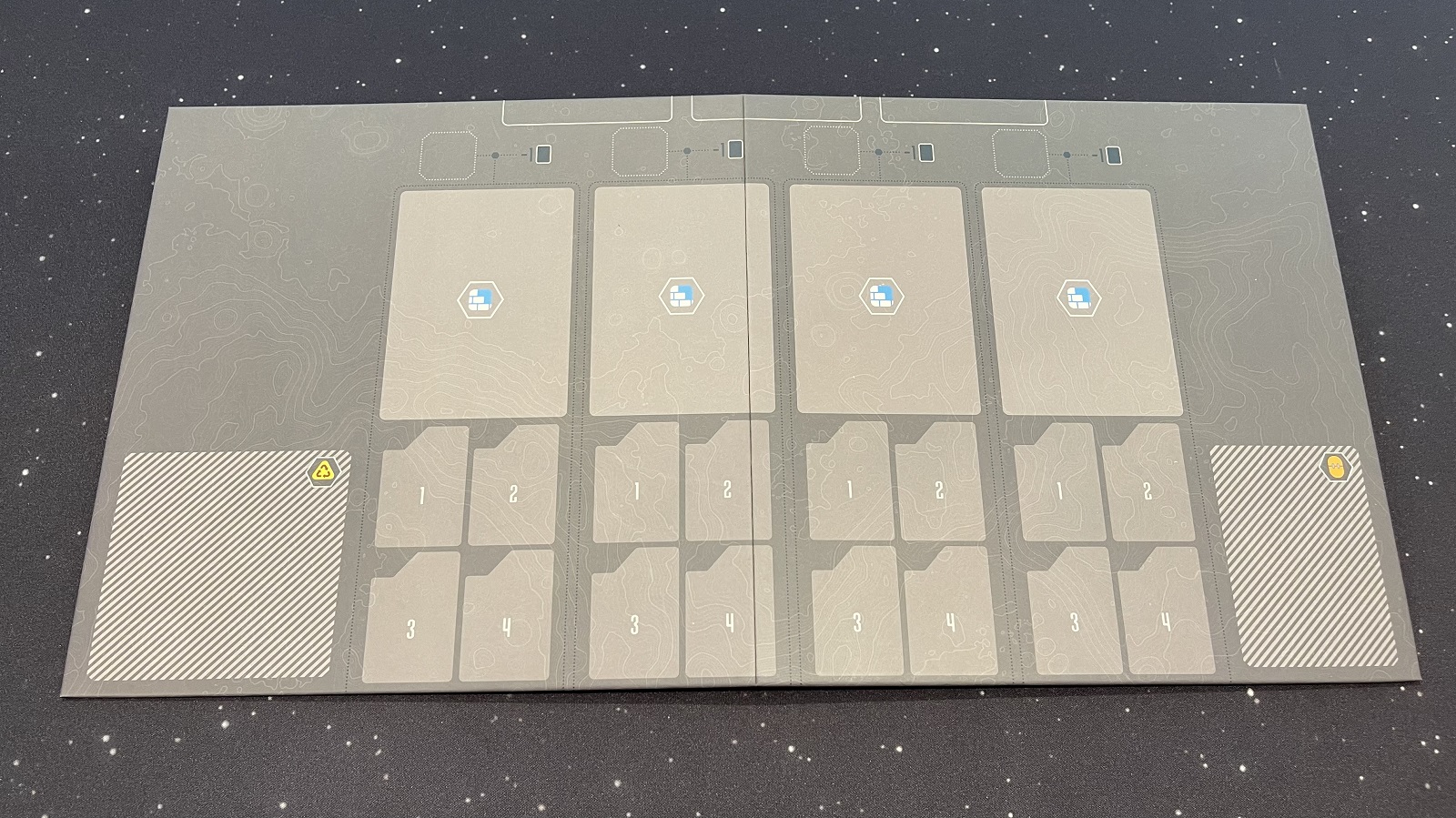
Game board.
When players set up the game, they will deal four face-up Construction cards to the board in the center of the table and place one Project tile below each of the cards in spaces on the board. In subsequent rounds, the number of Project tiles below the Construction cards increases by one each round. The fourth round of each phase, when there are four Project tiles below each Construction card, marks the end of that phase. Project tiles are used according to the letter on the back: As for the first phase, Bs for the second and Cs for the third. Three Concession cards are laid out as well, which provide short and long-term goals players can try to achieve before other players. Finally, everyone gets a hand of cards and then the first player starts playing.
LUNA Capital plays quickly and smoothly. On their turn, players choose a Construction card from one of four face up cards on the board and take the associated Project tiles located below the card on the board. Then the player chooses a construction card from their hand and plays it into the tableau in front of them, paying attention to the number sequence of the cards, ensuring that the card number is higher than the card to the left in the row. After playing a construction card, they play all of the Project tokens they just picked up, trying to place them in the most advantageous pattern for scoring at the end of the game. While playing, players should keep an eye on the Concession cards to see if they can lay out their Project tiles in a pattern that will let them be the first (or tie for first) to claim a concession, which will give them points. By the end of each phase, each player will have laid out four Construction cards and ten Project tiles and it is here that players check to see if they’ve met one of the conditions set forth on the Concession cards. By the end of the third round, players will have a tableau consisting of twelve Construction cards with up to thirty Project tiles placed on them.
There is a handy single player mode that uses the back of the board and pits you against an Automaton. It basically works like a two player game with a few modifications. Instead of someone making choices for it, the Automaton takes Construction and Project tiles according to a set pattern. The Automaton’s cards and tiles are not placed into a tableau, rather it scores the cards and tiles it has at the end of the game based on a scoring system in the rules, it also gets points for the Concessions. The single player version is handy for practicing tile and card placement.
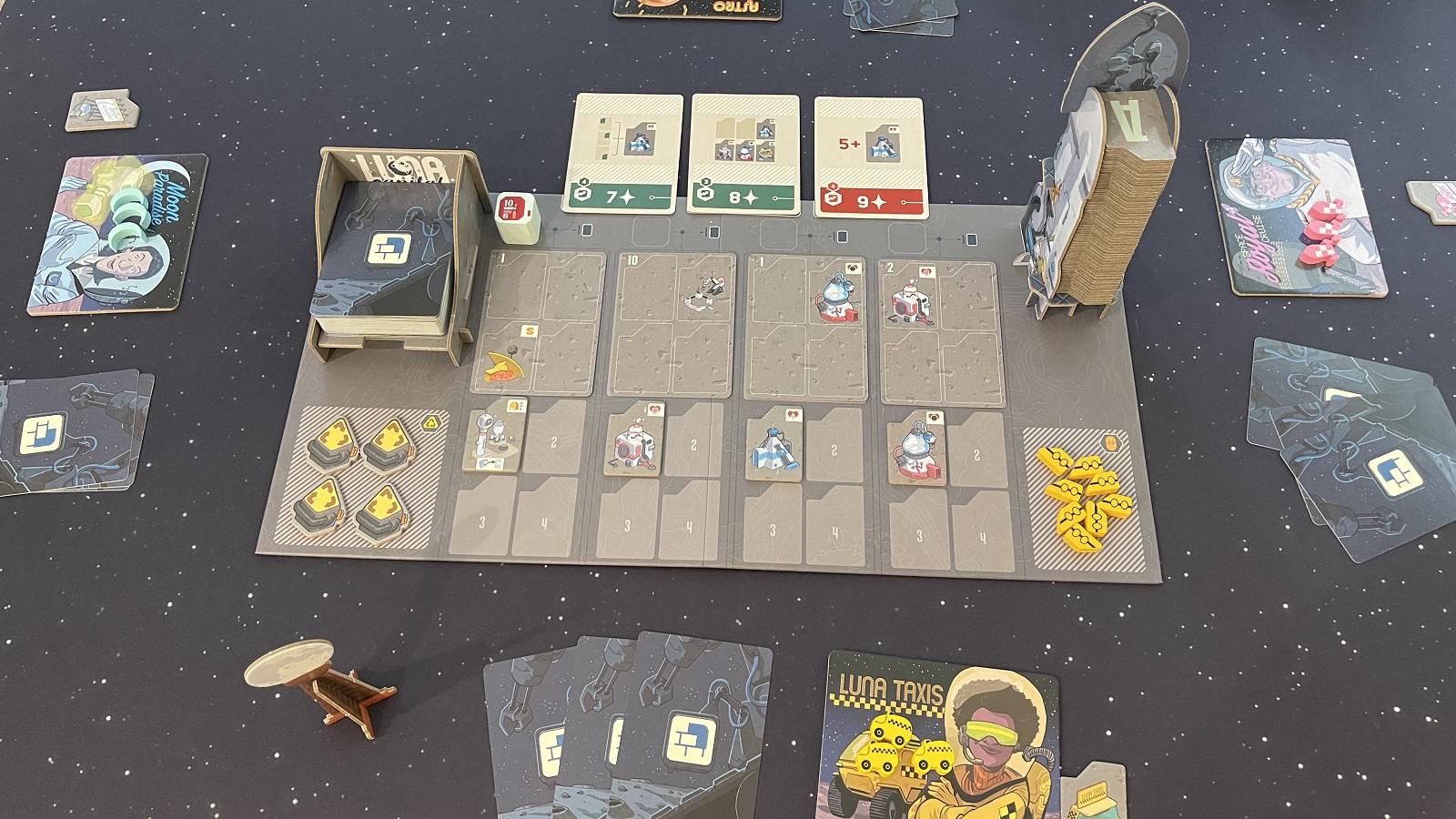
LUNA Capital game set up.
Playing the game is fun and engaging, you are constantly thinking about possible tile and card combinations. There’s very little player interaction here; you are in a race for the highest score, not a fight, so some may not like that. While some may try to take cards and tiles to prevent opponents from getting them, it’s almost always better to choose the most effective card and tile group for yourself, since whatever comes out after your choice could completely change your opponent’s plans.
Here’s where we encountered the only major hiccup in our enjoyment. We had two games in a row that saw one player take a commanding lead just from excellent card and tile selection opportunities and one game where another player couldn’t seem to catch a break. While a lot of the game is maximizing what you have on hand, when one player happens to get several synergistic card and tile combos in row, it had some players wishing for an ability to hinder their opponent. Maybe the ability to play tiles onto your opponent’s tableau that may hinder or slow their plans would work.
Figuring out the iconography took some work, which meant the rulebook got passed around a lot, so some player references would have been nice here. However Devir, a company out of Spain, published the game in five languages – that is there are five separate rulebooks (Spanish, English, Italian, Catalan, and Portuguese) – and only iconography on the game pieces. This means reference sheets would have been an additional cost times five. Maybe a download from their website, though?

End of a two player game.
Other than trying to remember what everything stands for, the other issue was trying to remember how everything scores. Some people got all the way to scoring at the end of the game and discovered that they misunderstood how certain tiles scored, so a practice game is not unwarranted, or at least a good briefing to all new players stressing the end game scoring conditions.
LUNA Capital
Great
LUNA Capital is a solid game with a lot going for it. There are plenty of options for players to think through. From the card and tile selection process to determining where to place them all, each turn is engaging and tests your planning skills. It would be nice to have options for a way to impact your opponents to help stymie the runaways, either a catchup mechanism or some kind of direct interaction. That aside, LUNA Capital is one to have in your collection.
Pros
- Excellent components
- Quick gameplay
- Various scoring methods lead to interesting choices
Cons
- Challenging iconography
- Possible runaway leader
